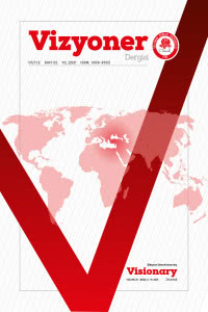FARKLI BAKIŞ AÇISI KAZANMAK İÇİN BEYİN FIRTINASI MODELLERİ
Einstein’ın sorunların çözümüyle ilgili önemli bir tespiti, problemlerin onları oluşturan aynı düşünce düzeyiyle çözülemeyeceği yönündedir. Öyleyse başka bir bakış açısı nasıl yakalanacak? Bunun için farklı bakış açısını çağrıştıracak metodolojik beyin fırtınası metotları mevcut mu? Bu makalede “alternatif dünyalar, zıtlıklar, 10’un gücü” beyin fırtınası metotları ile mevcut unsurlar farklı bakış açılarıyla birleştirilip yeni çözümler üretme yolları gösterilecek. Video kiralama, eğitim, bankacılık, hastane, catering, dondurulmuş gıda, ATM, birimlerin yeniden organizasyonu üzerine farklı sektörlerden örnek çalışmalar ele alınacak. İnsanları farklı düşünmeye zorlamak satrancı hiç bilmeyen bir kişiye “Rakibini mat et.” demektir. Çerçeve dışına bakılmadan önce çerçevede (ve içinde) sonrasında çerçevenin dışında nereye bakılacağının araştırılması gerekir. Beyin fırtınası öncesi ana husus problemin ve unsurların tespitidir. Bu unsurların çözümü için kaynak mekânların arayışına geçilir. Sonrasında beyin fırtınası yapılır. Rastgele iki farklı kavramın birleştirilmesi ile aşılama yapılmaya çalışılmaz.
Anahtar Kelimeler:
İnovasyon, Farklı Düşünme, Beyin Fırtınası, Alternatif Dünyalar, Zıtlık, 10’un Gücü
MODELS OF BRAINSTORMING FOR GAINING A DIFFERENT POINT OF VIEW
Einstein's remarkable analysis on the solution of the problems is that “Problems cannot be solved by the same level of thinking that created them.” So how another perspective is captured? For that purpose, is there any methodological brainstorming method that would suggest a different point of view? In the article, “alternative world, contradictory, power of ten” methodologies of brainstorming are explored to combine the old things with new perspectives. By using these brainstorming methods new ideas for video renting, education, banking, healthcare sector, catering, frozen food, ATM and re-organization are developed. Asking people to think differently is like to force someone who does not how to play chess to “checkmate”. Before looking out of the box, it is necessary to determine where to look inside and then outside the box. Before the brainstorming session, the main issue is the determination of the problem and its components. Then, for the solution of these components the search of resources is initiated. Thereafter, brainstorming is realized. Two unrelated concepts are not randomly chosen and combined.
Keywords:
Innovation, Different View, Brainstorming, Alternative World, Contrast, Power of Ten,
___
- Beverly, R.I. (2013). Design Thinking for Entrepreneurs and Small Businesses: Putting the Power of Design to Work, New York: Apress.
- Brown, T. (2008). “Design Thinking”, Harvard Business Review, 5(3), 56-65.
- Brown, T. (2009). Change by Design: How Design Thinking Transforms Organizations and Inspires Innovation, New York: Harper Business.
- Bushey, B. (2014). “Netflix CEO Confesses He Tried To Sell The Company To Blockbuster”, Business Inside, http://www.businessinsider.com/blockbuster-missed-buying-netflix-2014-1, (Erişim Tarihi: 5 Mart 2018).
- Diehl, M. ve Strpebe, W. (1987). “Productivity Loss In Brainstorming Groups: Toward the Solution of a Riddle”, Journal of Personality and Social Psychology, 53(3), 497-509.
- Drucker, P. (2007). Management Challenges for the 21st. Century, New York: Butterworth-Heinemann.
- Goodeeads. (2018). Einstein’s Quote, https://www.goodreads.com/quotes/320600-we-can-not-solve-our-problems-with-the-same-level, (Erişim Tarihi: 20 Aralık 2018).
- Higgins, A., Hodgson, P. ve Travis, D. (2014). Bright Ideas for User Experience Researchers, London: Ebook.
- Kelley, T. (2005). The Ten Faces of Innovation: IDEO's Strategies for Beating the Devil's Advocate & Driving Creativity Throughout Your Organization, New York: Doubleday.
- Kelley, T. ve Kelley, D. (2014). Yaratıcı Özgüven İçimizdeki Yaratıcı Potansiyeli Serbest Bırakmak, İstanbul: Optimist Yayınları.
- Kumar, V. (2012). 101 Design Methods: A Structured Approach for Driving Innovation in Your Organization, Chicago: Wiley.
- Liedtka J. ve Ogilvie, T. (2011). Designing for Growth, New York: Columbia Business School.
- Liedtka, J., King, A. ve Bennett, K. (2014). Solvıng Problems With Design Thinking, New York: Columbia Business School.
- Luma Institute (2012). Human Centred Design, Philadelphia: Luma Institute Press.
- Luma Institute. (2014). “Innovation of Taxanomy”, Harvard Business Review, Jan/Feb Volume, 40-46.
- Owens, D. A., (2011), Creative People Must Be Stopped: 6 Ways We Kill Innovation. New York: Jossey-Bass.
- Peterson, A., (2013). “Netflix Has Won: Blockbuster is Closing Its Last Retail Stores”, The Washington Post, https://www.washingtonpost.com/news/the-switch/wp/2013/11/06/netflix-has-won-blockbuster-is-closing-their-last-retail-stores/?utm_term=.6927dc366432, (Erişim Tarihi: 20 Ağustos 2018).
- Standford D. School. 2010. Power of Ten, https://dschool-old.stanford.edu/groups/k12/wiki/faf1d/powers_of_ten.html, (Erişim Tarihi: 21 Şubat 2018).
- Sutton, B. (2004). What Is Creativity?, http://ecorner.stanford.edu/authorMaterialInfo.html?mid=1187, (Erişim Tarihi: 7 Mart 2015).
- Sutton, B. (2007). Weird Ideas That Work: How to Build a Creative Company, New York, Free Press.
- Yayın Aralığı: Yılda 4 Sayı
- Başlangıç: 2009
- Yayıncı: Süleyman Demirel Üniversitesi
Sayıdaki Diğer Makaleler
FARKLI BAKIŞ AÇISI KAZANMAK İÇİN BEYİN FIRTINASI MODELLERİ
Ercan OKTAY, Muhammet Ali ÇELEBİ
KURUMSAL SOSYAL SORUMLULUK VE AKTİVİZM: İLİŞKİSEL DÜZLEMDE EPİSTEMOLOJİK BİR YÖNELİM
Ümit ARKLAN, Nurullah Zafer KARTAL
Selda LİMON, Nurdan ORAL KARA, Ömer Lütfi ANTALYALI
TURİST REHBERLİĞİ MESLEĞİNDE ROBOT REHBERLERİN YÜKSELİŞİ
DEFANSİF TIBBIN NEDENLERİNİN HEKİM GÖZÜYLE DEĞERLENDİRİLMESİ
Aynur TORAMAN, İlker Hüseyin ÇARIKÇI
KURUMSAL AHLÂK PERSPEKTİFİNDEN HASTANE AHLÂKI
DUYGUSAL EMEK İLE İŞ DOYUMU ARASINDAKİ İLİŞKİ: HEKİMLER ÜZERİNDE BİR UYGULAMA
İNŞAAT SEKTÖRÜNDE KAYIT DIŞI İSTİHDAMIN İNCELENMESİ: DENİZLİ İLİ ÖRNEĞİ
